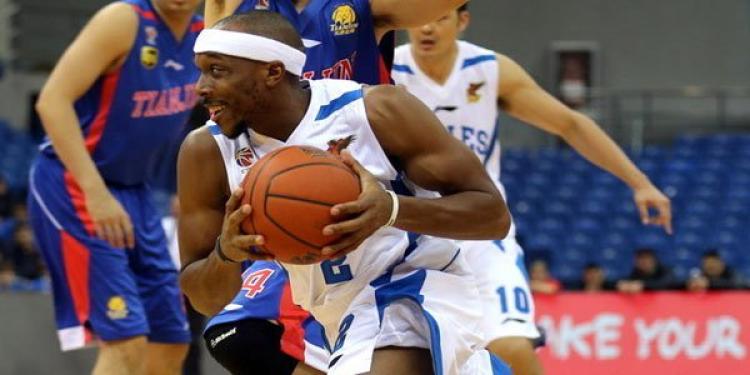How Chinese Basketball Became More Than a Dumping Ground for Washed-up American Stars
Posted: December 31, 2014
Updated: October 6, 2017

Less than two decades ago the CBA couldn’t get an American to come over to play basketball. Now, it can’t keep them out.
The People’s Republic of China was undergoing rapid economic transformation by the mid-1990s. Peasants were pouring into coastal manufacturing centers, ritzy housing developments and commercial skyscrapers were popping up in Beijing and Shanghai, and the world was consuming goods “Made in China.”
But to former NBA player John Spencer—who arrived in China in 1996—the picture was less than rosy. Used to the pampered life of an American professional athlete, China was a land of material deprivation and intolerable inconvenience.
His recollections seem almost comical in hindsight: a toilet he called the “the nastiest hell hole you could ever imagine,” a washing machine he couldn’t run together with the heating because the building’s power would go out, the unspeakable pollution. Then, there was the food: “I went over to China weighing 265 pounds. When I came home, I was 225.”
During the mid-to-late 1990s it wasn’t easy to convince an American to come to China, let alone a professional athlete. But IMG, the marketing arm of the CBA, opened its wallet and told American players to name their price.
Spencer went from earning $12,000 per month during his first season to $30,000 during his second, this at a time when some of his Chinese teammates were only making $200 per month. The league got a shot in the arm in 1999 when NCAA player Chris Andersen left Blinn College to sign a contract with the Jiangsu Nangang Dragons.
The foreign players were tremendously popular with Chinese fans. And along with the money, that fan admiration helped convince several of them to stay long-term. As Spencer put it:
They appreciate what you bring to the table, and that's why the Americans like going there, because the Chinese fans are so appreciative of what you bring to the game—your passion, your skills, your desire, your hard work. That's what makes the country so special. It's an amazing place.
The CBA got a lot more credibility in 2001 and 2002 when a trio of homegrown players—Yao Ming, Mengke Bateer, and Wang Zhizhi—popped up on NBA rosters, with Yao destined for stardom and worldwide celebrity. The 2008 Beijing Summer Olympics brought new hotels and restaurants, things that made life more comfortable for many American players.
Former stars Stephon Marbury and Steve Francis crossed the Pacific in 2010. Marbury is currently the country’s most popular professional athlete, and Beijing city officials commissioned the building of a statue of him in a public park. But still, Marbury and Francis came to China only because they had burned all of their bridges in the NBA.
The Chinese economy continues to grow, and living conditions and player salaries have grown along with it. The league’s highest-profile players make roughly $2 million per year, and the second-tier guys can expect a comfortable salary around the $400,000 range.
This year 18-year old prep phenom Emmanuel Mudiay generated unprecedented buzz for the CBA when he announced that he would forgo the NCAA and sign a $2.5 million contract with the Dongguan Southern Tigers. Mudiay is considered a top contender to be selected first overall in the 2015 NBA Draft.
The country is laced with underground betting shops, and many Chinese bet with online sportsbooks or go to Hong Kong and Singapore to place wagers. While Bet365 Singapore closed in 2014, the country remains a popular destination for basketball bettors. The Chinese love basketball, and now they have one of the world’s best professional leagues.
The People’s Republic of China was undergoing rapid economic transformation by the mid-1990s. Peasants were pouring into coastal manufacturing centers, ritzy housing developments and commercial skyscrapers were popping up in Beijing and Shanghai, and the world was consuming goods “Made in China.”
But to former NBA player John Spencer—who arrived in China in 1996—the picture was less than rosy. Used to the pampered life of an American professional athlete, China was a land of material deprivation and intolerable inconvenience.
His recollections seem almost comical in hindsight: a toilet he called the “the nastiest hell hole you could ever imagine,” a washing machine he couldn’t run together with the heating because the building’s power would go out, the unspeakable pollution. Then, there was the food: “I went over to China weighing 265 pounds. When I came home, I was 225.”
IMG tasked with importing talent
But his team was determined to keep him there. Chinese Basketball Association (CBA) officials saw the poor state of basketball in their country—basketball was tremendously popular but the country had no homegrown stars. So they set to work importing “foreign specialists,” and John Spencer was eventually followed by a stream of former NBA and NCAA players.During the mid-to-late 1990s it wasn’t easy to convince an American to come to China, let alone a professional athlete. But IMG, the marketing arm of the CBA, opened its wallet and told American players to name their price.
Spencer went from earning $12,000 per month during his first season to $30,000 during his second, this at a time when some of his Chinese teammates were only making $200 per month. The league got a shot in the arm in 1999 when NCAA player Chris Andersen left Blinn College to sign a contract with the Jiangsu Nangang Dragons.
The foreign players were tremendously popular with Chinese fans. And along with the money, that fan admiration helped convince several of them to stay long-term. As Spencer put it:
They appreciate what you bring to the table, and that's why the Americans like going there, because the Chinese fans are so appreciative of what you bring to the game—your passion, your skills, your desire, your hard work. That's what makes the country so special. It's an amazing place.
NBA cast-offs continue to pour in
After the first cast of former NBA players appeared during the 1990s more became coming in. Unsurprisingly, it was mostly out-of-work NBA-ers and former NCAA players who weren’t picked up in the NBA draft. Ageing players like Ike Austin, Scott Burrell, Lamond Murray, Mark Strickland, and Roy Tarpley appeared on CBA rosters.The CBA got a lot more credibility in 2001 and 2002 when a trio of homegrown players—Yao Ming, Mengke Bateer, and Wang Zhizhi—popped up on NBA rosters, with Yao destined for stardom and worldwide celebrity. The 2008 Beijing Summer Olympics brought new hotels and restaurants, things that made life more comfortable for many American players.
Former stars Stephon Marbury and Steve Francis crossed the Pacific in 2010. Marbury is currently the country’s most popular professional athlete, and Beijing city officials commissioned the building of a statue of him in a public park. But still, Marbury and Francis came to China only because they had burned all of their bridges in the NBA.
America’s loss is China’s gain
The single watershed moment in the development of professional basketball in China was the 2011 NBA lockout. It had been obvious for some time that the 2011-12 Season wouldn’t start on time, and several NBA players chose to start the season in China rather than sit around for a deal to be struck.• John Spencer was the first American to play in the CBAThis time, household names in the prime of their careers’ landed on Chinese shores: J.R. Smith, Wilson Chandler, and Aaron Brooks. A few former stars like Gilbert Arenas (who once made gambling news by pulling a gun on a teammate over an unpaid gambling debt), Kenyon Martin and Tracy McGrady (Yao’s former teammate with the Houston Rockets) showed up too.
• Emmanuel Mudiay signed a $2.5 million deal with Dongguan Southern Tigers
• Stephon Marbury is China’s most popular player
The Chinese economy continues to grow, and living conditions and player salaries have grown along with it. The league’s highest-profile players make roughly $2 million per year, and the second-tier guys can expect a comfortable salary around the $400,000 range.
This year 18-year old prep phenom Emmanuel Mudiay generated unprecedented buzz for the CBA when he announced that he would forgo the NCAA and sign a $2.5 million contract with the Dongguan Southern Tigers. Mudiay is considered a top contender to be selected first overall in the 2015 NBA Draft.
The business of basketball is good
Basketball has been popular in China for almost a century, but it has exploded over the past two decades as the quality of play in the CBA has improved. Millions of Chinese attend games, tune in on TV, and even skirt around Chinese gambling laws to place wagers on games.The country is laced with underground betting shops, and many Chinese bet with online sportsbooks or go to Hong Kong and Singapore to place wagers. While Bet365 Singapore closed in 2014, the country remains a popular destination for basketball bettors. The Chinese love basketball, and now they have one of the world’s best professional leagues.
Related content
Subscribe
0 Comments












